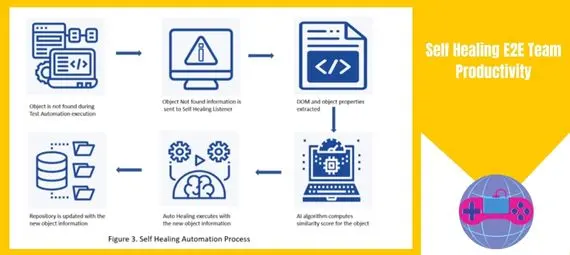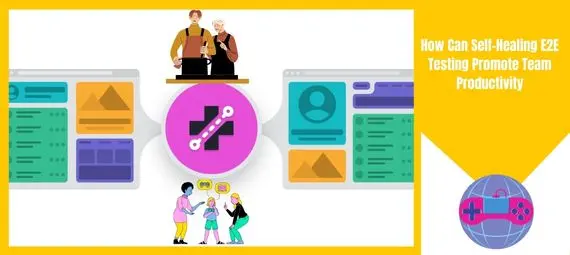Statistics from Zionmarket research show that Self-healing end-to-end test automation can grow the testing market from $1.5 billion in 2019 to over $4 billion by the end of 2026 by offering DevOps teams increased productivity, shorter test cycle, increased positive feedback from customers, and more.
This article will explore the role of self-healing in end-to-end test automation and how it can increase team productivity, resulting in significant growth in test market revenue.

What is E2E test automation?
End-to-end (E2E) testing is a test automation type that tests applications under development from start to finish, testing all possible scenarios to ensure that the application functions optimally, with all features working as expected. This test simulates the real-world user and complements other test automation types like API, functional, unit, and system testing by verifying all integrated and external components as a single unit.
An e2e testing ensures that:
All integrated components and external interfaces are validated
The UI, backend, and hardware functions are up to expectations from the end-users point of view.
If you want a better experience of E2E automation so you can go with the NoLagVPNs for a better experience.
Also Read:
NordVPN Coupon code to serve a huge discount and also access anonymously to the internet.
The place of self-healing in e2e test automation
E2e tests frequently fail due to their flaky nature, inhibiting continuous integration in software development pipelines. A recent study shows that more than 74% of test automation types fail due to their flaky nature, caused by:
·Regular code changes tied to UI object locators like Name, ID, Xpath, tag, link test, etc
·Longer wait time needed to sync element rendering in web pages
·Faulty test automation codes.
This poses major drawbacks as fixing flaky e2e test codes takes up additional time and resources, which can be put to better use. Also, manually identifying and updating changes in object repositories can be labor-intensive and time-consuming, resulting in increased testing costs and longer test cycles. This challenge can be fixed using self-healing e2e test automation, which can fix flaky or broken e2e test scripts.
Self-healing e2e test is an e2e test automation type that integrates Machine Learning functionality to enable an e2e test automation to make automatic changes like performing auto script maintenance without human intervention whenever there’s a break in automation test scripts due to changes in object properties like ID, Name, CSS, XPath, etc.
How can Self-healing E2E testing promote team productivity?
By adopting self-healing e2e automation test types, DevOps teams can adopt the Shift-Left approach, bringing about increased speed and efficiency, resulting in increased productivity and shorter testing cycles.
There are many e2e, self-healing integrated test automation tools that can detect and fix changes automatically without human intervention; one such tool is Functionalize, an automation tool that incorporates Machine Learning for self-healing. Additionally, this tool comes with a detailed e2e testing guide that supports the DevOps team, from start to finish, and provides extensive information on how to plan, design, and execute e2e testing.
Roles of Self-healing in End-to-end test automation
Here are 3 end to end test automation points by which you can learn about their roles.
Eliminate the need for human intervention in test maintenance
Challenges faced by applications under development include a growing number of scenarios and use cases to test, validating app components and features each time there are changes. This results in a large amount of overhead software testing, which can be challenging when using an e2e automation test tool that lacks self-healing functionalities. In such instances, much time, energy, and resources will be required to meet the growing volume of tests needed to verify that the software application under development satisfies the required market quality standard.
This results in the following:
- Failed tests due to poor maintenance of test automation scripts
- A decline in test reliability
- Production of unstable applications
Longer feedback time and delay in implementing feedback.
Issues encountered in the deployment of e2e test automation without self-healing are due to the need for human intervention each time there is a change in object properties or a break in test scripts. Deploying self-healing e2e test automation eliminates the need for test automation maintenance since it doesn’t require human intervention, thereby preventing software failure, improving test reliability, and promoting team efficiency.
Builds confidence in testing processes
Continuous implementation of self-healing e2e test automation yields reliable test results that promote brand quality and restore confidence in test automation processes in all stages of software development.
Saves substantial time and resources
Implementing self-healing e2e test automation helps the DevOps team save time and resources by taking care of repetitive tasks and maintenance work. Therefore, DevOps teams can focus on more productive tasks.
The future of self-healing e2e test automation in promoting team productivity
Self-healing test automation is a modern advancement in test automation with solid roots in Machine Learning and Data science. The emergence of self-healing e2e testing is witnessing a broader adoption rate than e2e testing tools lacking self-healing capabilities due to its more intelligent and autonomous approach to test automation.
Hopefully, self-healing automation tools will replace manual and non-healing automation tools as the demand for self-healing e2e test tools continues to rise astronomically.
Enhance your internet browsing by knowing the ways to secure your internet browser.
Final Thoughts
The benefits of implementing self-healing test automation are far more significant than the efforts required to change from non-self-healing to self-healing test automation. Statistics show that DevOps teams that adopt self-healing e2e testing are more likely to record improved productivity and get more customer satisfaction feedback compared with DevOps teams yet to adopt self-healing e2e testing.
Functionize as a Self-healing end-to-end test automation solution enables DevOps to create, manage, and run application types like API, automated browsers, etc. It can also capture more than 40 object properties that can help refine its accuracy and productivity when deployed in a software development pipeline.
